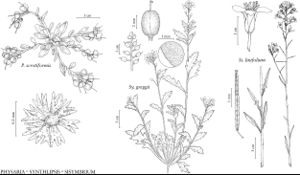Sisymbrium
Sp. Pl. 2: 657. 1753.
| Taxon | Illustrator ⠉ | |
|---|---|---|
 | Physaria scrotiformis Synthlipsis greggii Sisymbrium linifolium | Yevonn Wilson-Ramsey Barbara Alongi Yevonn Wilson-Ramsey |
Plants not scapose; pubescent or glabrous. Stems often erect, sometimes ascending, rarely subprostrate or decumbent, often branched distally, sometimes unbranched. Leaves basal and cauline; petiolate or sessile; basal rosulate or not, petiolate, blade margins dentate, sinuate, lyrate, runcinate, or pinnately lobed [entire]; cauline similar to basal, (blade smaller distally). Racemes (several-flowered), often considerably elongated in fruit. Fruiting pedicels ascending, divaricate, or erect, slender or stout (sometimes as wide as fruit). Flowers: sepals ovate or oblong, (glabrous or pubescent); petals yellow, obovate, spatulate, oblong, or suborbicular, (longer than sepals), claw differentiated from blade, (subequaling or longer than sepals, apex obtuse or emarginate); stamens tetradynamous; filaments not dilated basally; anthers oblong, (apex obtuse); nectar glands confluent, subtending bases of stamens, median glands present. Fruits usually sessile, rarely shortly stipitate (gynophore to 1 mm), usually linear, rarely lanceolate or subulate, smooth or torulose; valves each with prominent midvein and 2 conspicuous marginal veins, usually glabrous, rarely pubescent; replum rounded; septum complete; style subclavate [clavate, conical, cylindrical]; stigma capitate (lobes not decurrent). Seeds plump, not winged, oblong [ovoid]; seed-coat (reticulate or papillate), not mucilaginous when wetted; cotyledons incumbent. x = 7.
Distribution
North America, Europe, Asia, Africa, in Central America, South America, Australia
Discussion
Species 41 (8 in the flora).
All except one of the eight species of Sisymbrium in North America are introduced Eurasian weeds. Sisymbrium linifolium (Nuttall) Nuttall was retained in Sisymbrium by both E. B. Payson (1922) and O. E. Schulz (1924). Greene took that species as the type of his genus Schoenocrambe. R. C. Rollins (1982b, 1993) maintained Schoenocrambe and (1993) recognized Sisymbrium auriculatum as the only native North American species of the genus. Molecular studies (S. I. Warwick et al. 2002, 2005) clearly demonstrated that Schoenocrambe should be united with Sisymbrium, that S. linifolium is most closely related to the Eurasian S. polymorphum (Murray) Roth (as was suggested by both Payson and Schulz), that 40 of the 41 species of Sisymbrium are native to the Old World, and that S. auriculatum is a member of the New World Thelypodieae and is unrelated to Sisymbrium. See also Warwick and I. A. Al-Shehbaz (2003) and Al-Shehbaz (2005).
Selected References
Lower Taxa
Key
| 1 | Racemes bracteate, flowers fasciculate. | Sisymbrium polyceratium |
| 1 | Racemes ebracteate, flowers not fasciculate | > 2 |
| 2 | Fruits subulate-linear, (0.7-)1-1.4(-1.8) cm; fruiting pedicels appressed to rachises. | Sisymbrium officinale |
| 2 | Fruits narrowly linear, 2-10(-13) cm; fruiting pedicels not appressed to rachises | > 3 |
| 3 | Fruiting pedicels nearly as wide as fruit | > 4 |
| 3 | Fruiting pedicels narrower than fruit | > 6 |
| 4 | Distal cauline leaf blades divided into linear or filiform lobes; sepals cucullate; fruiting pedicels (4-)6-10(-13) mm. | Sisymbrium altissimum |
| 4 | Distal cauline leaf blades not divided into linear or filiform lobes; sepals not cucullate; fruiting pedicels 1-6 mm | > 5 |
| 5 | Fruiting pedicels 1-2(-3) mm; petals 1.4-2(-2.5) mm; seeds 30-46(-54) per fruit. | Sisymbrium erysimoides |
| 5 | Fruiting pedicels 3-6 mm; petals (6-)7-9(-10) mm; seeds (60-)80-100(-140) per fruit. | Sisymbrium orientale |
| 6 | Perennials; distalmost cauline leaf blades usually filiform to linear, rarely oblanceolate, 1-3.5(-5) mm wide. | Sisymbrium linifolium |
| 6 | Annuals; distalmost cauline leaf blades oblanceolate or oblong (in outline), not filiform or linear, 10-30 mm wide | > 7 |
| 7 | Plants usually densely hispid (at least proximally); petals 6-8 mm; young fruits not overtopping flowers. | Sisymbrium loeselii |
| 7 | Plants glabrous or sparsely pubescent; petals 2.5-3.5(-4) mm; young fruits overtopping flowers. | Sisymbrium irio |
"elongated" is not a number."elongated" is not a number."thick" is not a number.